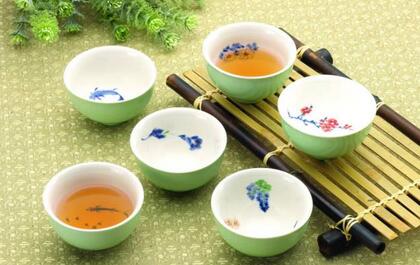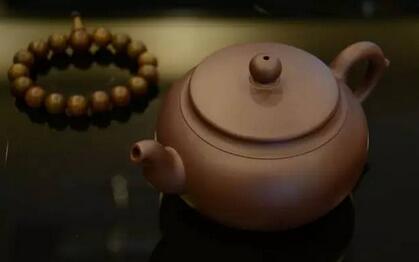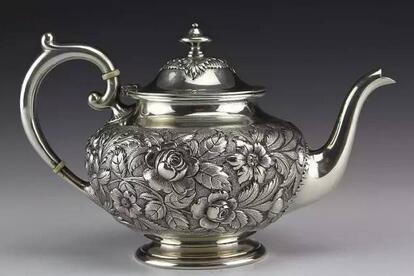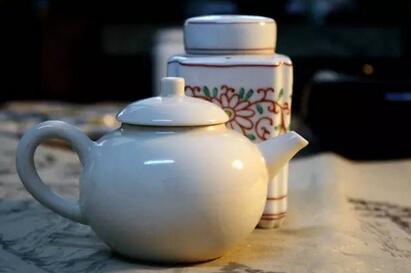
Purple Clay Pot (Ceramic)
The purple clay pot is a unique handmade pottery craft of the Han Chinese. It is made from purple clay and originates from Dingshu Town, Yixing, Jiangsu, also known as the Yixing purple clay pot.
1. Flavor Preservation
The purple clay pot excels at preserving the tea's original flavor, retaining its aroma and enhancing its color, aroma, and taste without dispersing the fragrance. As noted in "The Treatise on Superfluous Things," it "neither overpowers the tea's aroma nor imparts a boiled-water taste."
2. Prevents Spoilage
The lid of the purple clay pot has small holes that absorb steam, preventing condensation from dripping into the tea and accelerating fermentation. Thus, tea brewed in a purple clay pot remains aromatic and less prone to spoilage. Even overnight tea does not develop a stale taste, making it easy to clean and maintain hygiene. The pot also does not retain odors after long periods of disuse.

Purple Clay Pot
Silver Pot (Metal)
Metal teaware refers to utensils made from gold, silver, copper, iron, tin, and other metals. These are among the oldest daily-use items in China, dating back to the widespread use of bronze ware between the 18th century BCE and 221 BCE, before the Qin Dynasty unified China. Ancient people used bronze plates for water and vessels like "jue" and "zun" for wine, which could also hold tea.
1. Softens Water
Boiling water in a silver pot softens and thins the water, creating a silky-smooth texture akin to silk.
2. Removes Odors
Silver is odorless and chemically stable, resistant to rust, ensuring the tea's flavor remains untainted. Its excellent thermal conductivity helps dissipate heat from blood vessels, aiding in the prevention of cardiovascular diseases.
3. Antibacterial Properties
Modern medicine recognizes silver's antibacterial and anti-inflammatory properties, which promote detoxification and longevity. When water is boiled in a silver pot, it releases silver ions. These ions are highly stable, minimally reactive, and possess excellent thermal conductivity, making them effective at killing bacteria.

Silver Pot
Iron Pot (Metal)
1. Enhances Tea Aroma
Iron pots boil water at a higher temperature, which helps release and elevate the tea's aroma. This is especially beneficial for aged teas, as the high temperature better extracts their rich flavors and nuances.
2. Sweetens Tea
Mountain spring water, filtered through sandstone layers, contains trace minerals, particularly iron ions, and minimal chlorides, giving it a sweet taste ideal for tea. Iron pots release trace iron ions and absorb chlorides, mimicking the effects of mountain spring water.
3. Iron Supplementation
Iron is essential for blood production, with adults needing 0.8–1.5 mg daily. Severe iron deficiency can impair cognitive development. Studies show that using iron pots or pans for cooking and drinking increases iron absorption, helping prevent iron-deficiency anemia.
4. Excellent Heat Retention
Due to their thick material and superior sealing, iron pots retain heat exceptionally well during tea brewing, an advantage unmatched by other materials.

Iron Pot
Copper Pot (Metal)
1. Improves Anemia
Copper catalyzes hemoglobin synthesis. Anemia, often caused by iron deficiency, can be exacerbated by copper deficiency, as copper is crucial for hemoglobin production. Supplementing copper can help alleviate certain types of anemia.
2. Prevents Cancer
Copper inhibits cancer cell DNA transcription, aiding in tumor resistance. Some ethnic groups wear copper ornaments and use copper utensils, resulting in lower cancer rates in these regions.
3. Supports Cardiovascular Health
Recent U.S. studies confirm that copper deficiency is a major cause of coronary heart disease. Copper-dependent enzymes are vital for maintaining the elasticity of blood vessels. Without sufficient copper, these enzymes diminish, increasing the risk of cardiovascular diseases.

Copper Pot
Porcelain Pot (Ceramic)
Porcelain teaware is non-absorbent, produces a clear, resonant sound, and is prized for its white color, which highlights the tea's hue. It offers moderate heat conduction and retention, does not react chemically with tea, and preserves the tea's aroma and flavor. Its elegant design makes it ideal for brewing lightly fermented, aromatic teas.

Porcelain Pot